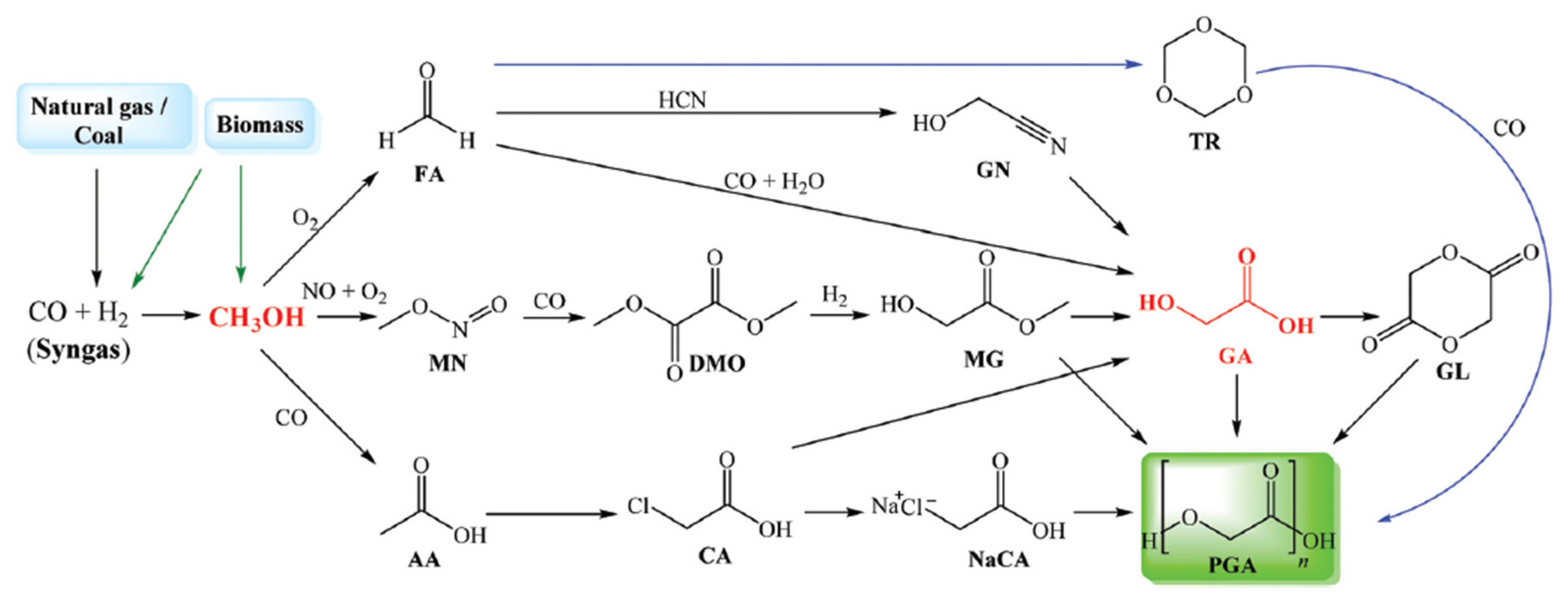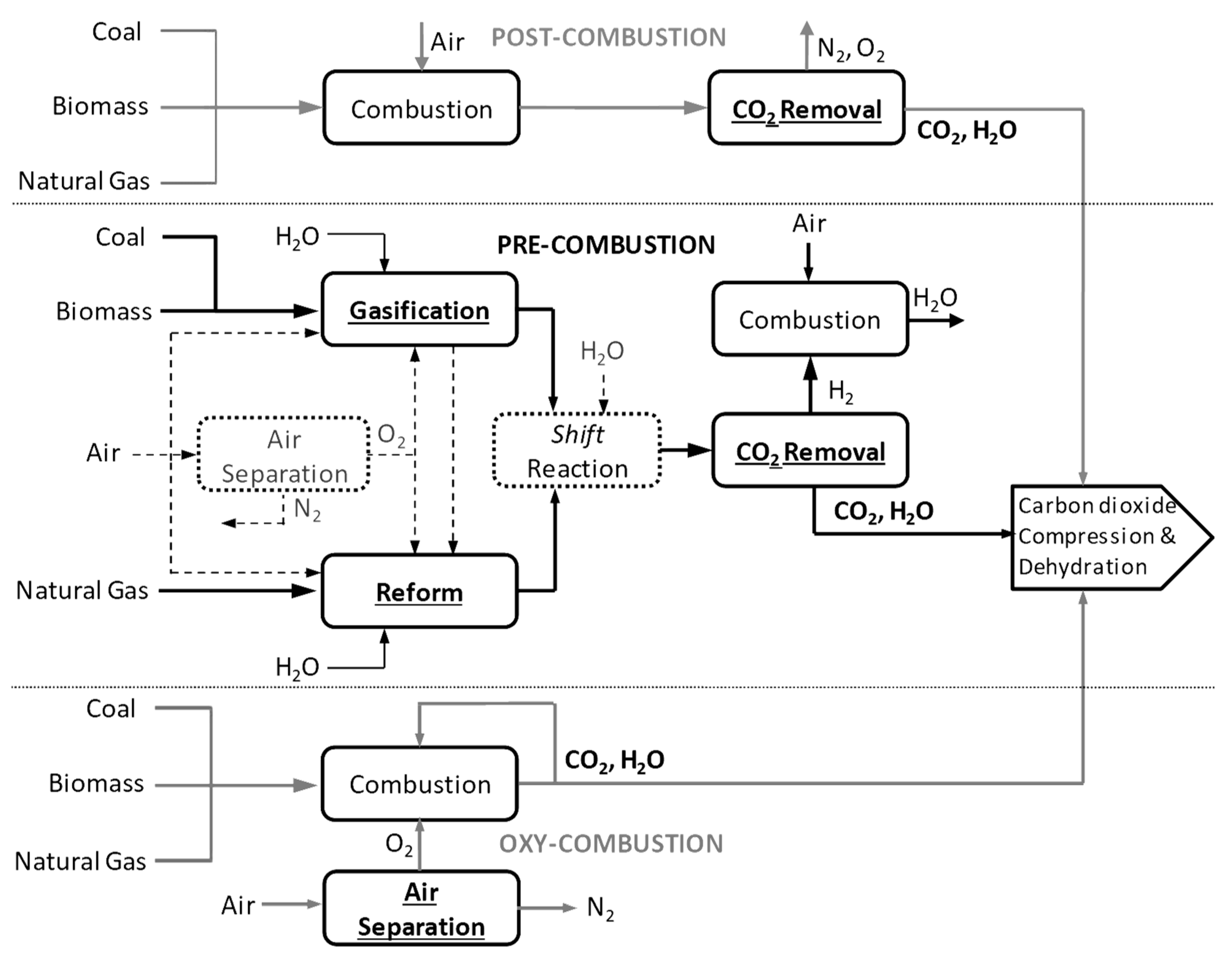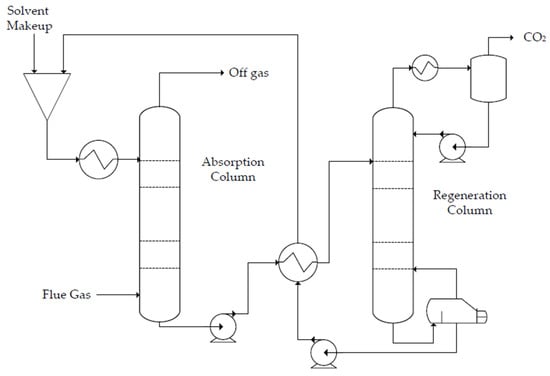In pre-combustion CO2 capture, the fuel (e.g., biomass, coal, natural gas) is firstly converted into syngas and then subjected to shift conversion to react CO and increase H2 content.
1. Introduction
To achieve the goals of the Paris Agreement, global anthropogenic CO
2 emissions should be zero by 2050, and although major CO
2 sources come from power, steel, and cement industries
[1][2], efforts from all areas of society will be needed. However, the challenge involves unequal abatement costs across sectors. For example, chemical and steel companies may face higher costs for decarbonization in comparison with electricity generation plants
[3]. In this scenario, carbon capture and storage (CCS) and carbon capture and utilization (CCU) are solutions for CO
2 abatement that are widely discussed in the literature
[4][5][6]. Both involve separation processes to avoid the release of CO
2 to the atmosphere, generated by conversion of fossil or biomass resources, differing mainly by fate of the CO
2 stream and whether it contributes to revenues of the project.
CCS prescribes sending captured CO
2 (e.g., from combustion, industrial separation, or direct air capture) to geological storage, returning carbon to underground locations if it comes from a fossil resource. Power plants with CCS have been extensively studied in the literature
[7] regarding challenges in the efficient capture and safe storage of CO
2 [8]. CCS can provide considerable reduction of global CO
2 emissions by 2050
[9][10], but the deployment of projects depends on a combination of favorable local aspects and leverages, like regulatory requirements and proper economic incentives
[11].
In turn, CCU encompasses all routes where CO
2 is used commercially to add revenues, either chemically as a raw material or physically as in enhanced oil recovery (EOR), among other uses. The concept may be regarded as a current “hot topic”, but it is not new. Back in 1972, a plant was launched in Texas for the purpose of improving productivity of old wells by EOR using CO
2 captured from natural gas. Most early projects addressed EOR and utilized CO
2 that had to be captured for other reasons (e.g., natural gas conditioning), but even in the 1970s there were studies considering the capture of CO
2 from flue gases, which is believed by some as the origin of the CCS/CCU concept
[8]. The chemical conversion of CO
2 has also been studied for many decades
[11], as a possible low-cost raw material, with possible uses in the production of methanol and methane by hydrogenation, as well as in carboxylation reactions to produce carbonates, acrylates, and polymers
[12][13]. However, since CO
2 is a relatively stable molecule, the processes are usually energy-intensive. Also, the reaction kinetics for CO
2 conversion require special catalysts
[14].
Beyond global warming concerns related to energy use and direct CO
2 emissions, other significant environmental problems are caused by non-biodegradable plastic waste. It is well known to impact ecosystems but may also indirectly lead to the emission of greenhouse gases (e.g., from landfilling and incineration)
[14][15][16]. This kind of waste mostly consists of common synthetic polymers like polyolefins (polyethylene, polypropylene), polyethylene terephthalate (PET), and nylon, as well as their combinations and composites. In this scenario, one sustainable alternative is to invest in the production of biodegradable polymers like polyglycolic acid (PGA), whose monomer (glycolic acid) can be produced from renewable feedstocks (
Figure 1), showing reduced lifetime (i.e., better biodegradability) when compared to other sustainable polymers (e.g., polycaprolactone and polybutylene adipate-co-terephthalate)
[15].
Figure 1. Reaction pathways from syngas to polyglycolic acid polymers.
Glycolic acid also has other applications, and its global demand has increased, with possible use in food, cosmetic, textile, and cleaning chemical industries
[17][18][19]. The production of glycolic acid from CO
2 involves the following sequence of steps: syngas generation (e.g., by gasification), CO
2 and/or CO separation (excess CO
2 can be geologically stored), methanol synthesis, methanol partial oxidation, and formaldehyde reaction with CO (carbonylation).
2. CO2 Capture
The production of polyglycolic acid can be carried out through different reaction pathways, shown in
Figure 1. The routes have in common the need for methanol synthesis, where hydrogen reacts with CO and CO
2. In this case, a CCU concept could be employed to replace syngas production, with CO
2 hydrogenation to methanol addressed by use of renewable H
2 from electrolysis. The CO
2 could be obtained through different capture technologies, with the choice being mainly a function of the characteristics of the gas carrying the CO
2 to be captured and the energy resource of the process; in a general way, the lower the CO
2 partial pressure and the carbon content of the resource gas, the more expensive the capture process. The capture strategies are generally classified into three main groups when applied to power generation processes: pre-combustion, post-combustion, and oxy-combustion
[20][21]. They are briefly described below.
In pre-combustion CO
2 capture, the fuel (e.g., biomass, coal, natural gas) is firstly converted into syngas and then subjected to shift conversion to react CO and increase H
2 content, as illustrated in
Figure 2. Syngas generation occurs between 700 and 1000 °C, and the required heat is usually supplied in situ by partial oxidation or indirectly by combustion. Then, H
2/CO
2 fractionation takes place, usually by chemical or physical absorption, and the H
2 stream experiences combustion. The advantage of the strategy relies mainly in performing separation with relatively high CO
2 fugacity, in comparison with typical flue gases of the post-combustion route. The major drawback is the high capital investment, which is a consequence of the much greater plant complexity
[22][23].
Figure 2. Overview of main conceptual routes for CO2 capture in power generation processes.
Post-combustion CO
2 capture concept consists of removing CO
2 from flue gas (
Figure 2). This method is particularly advantageous when the CO
2 content is relatively low
[24][25]. The concept allows easy CCS adaptation to various industrial and power settings, requiring minimum change in the original plant. In this case, chemical absorption with aqueous alkanolamines is a mature solution for this separation service, readily available for commercial implementation
[26]. The technology is well known for its use in natural gas processing, with more than 6 decades of application
[20]. The main drawback is the high operating cost linked to CO
2 removal in low fugacity from a low-pressure N
2-rich stream. Absorption processes are sensitive to the presence of NOx and SOx and require a solvent makeup to compensate for losses from volatilization, inactivation, or degradation
[23].
The process of oxy-combustion (
Figure 2) involves burning fuel with pure oxygen instead of air to minimize nitrogen introduction to the system, resulting in exhausts primarily composed of CO
2 + H
2O, which has the advantage of dismissing a separation process for CO
2 removal in exchange for a process for oxygen production. The economic competitiveness of this concept is thus highly dependent on air separation performance
[27], which usually entails high power demand and high capital investment
[28].
The various possible technologies for CO
2 separation can be categorized into five generic groups (
Figure 3): absorption, adsorption, membrane permeation, cryogenic distillation, and chemical looping combustion (CLC)
[24]. Chemical absorption with amines is the most mature technology, given the experience of decades of large-scale plant operation. These chemical solvents have high reactivity with CO
2, relatively high thermal stability, and high absorption capacity. The major drawback is the relatively high heating demand for solvent regeneration
[20]. Post-combustion capture by such amines in a thermal power station involves a countercurrent contact of the gas with the solvent in a packed column operated at nearly atmospheric pressure and a temperature of 40–70 °C
[25]. Some substances commonly used for this purpose are monoethanolamine (MEA), methyl-diethanolamine (MDEA), and 2-amino-2-methyl-1-propanol (AMP)
[29][30]. The mechanism involved in CO
2 chemical absorption by MEA is shown in Equations (1) and (2). Its regeneration heat, expressed by mass of captured CO
2, is nearly 4 GJ/ton
(CO2) if it is applied to mitigate emissions from a natural gas power plant. An alternative to minimize heating demand is to employ phase change solvents
[31], e.g., by addition of an alcohol to MEA, which allows reduction of the amount of solvent to be regenerated, thus decreasing the heating demand associated with CO
2 capture. The general flowsheet of a standard chemical absorption plant for CO
2 removal is shown in
Figure 4 [32]. Besides chemical absorption, physical absorption is also mature and commercially available (e.g., SELEXOL, RECTISOL, NMP PURISOL), being applicable when the stream is pressurized and when CO
2 has enough fugacity. Physical solvents are less selective—implying lower CO
2 purity—but can be regenerated at lower temperatures by stream depressurization.

Figure 3. Technologies applied for CO
2 separation process. Reprinted with permission from
[30].
Figure 4. Typical flowsheet of CO
2 chemical absorption by amine-based solvent. Adapted from
[32].
Separation by adsorption can occur through physical (e.g., using zeolites, activated carbon, or metal-organic frameworks) or chemical mechanisms (e.g., metal oxides, hydrotalcites, lithium zirconate)
[33], among which physical adsorption has been more frequently used for CO
2 capture. It involves a selective interaction between the target adsorbate CO
2 and a solid material, which retains the CO
2 in its surface, to later be regenerated, usually by pressure or temperature variation. At least two vessels installed in parallel are required for continuous cyclic operation: while one tower is regenerated, another one is active in the process. The cycle duration depends on adsorbent capacity and regeneration method (it usually operates for a few hours without regeneration if it is temperature-swing, but only a few minutes if it is pressure-swing)
[34].
A relatively new concept is the use of selective membranes to separate CO
2 from a gas stream. Membranes are semipermeable barriers that can be manufactured using different materials, which can be an organic (e.g., polymer) or inorganic type (e.g., ceramic, metallic). Separation by polymeric membranes has been more relevant in the field, and it is already utilized commercially for natural gas processing, since the stream is already found at high pressure, where it offers significant advantages of operational flexibility. The following two perspectives are important in the evaluation of membrane performance: permeability (for certain pressure drop) and selectivity (permeability ratio) of desired components. These determine component recoveries and stream purities after the separation process. The main drawbacks of gas permeation are low scalability (it is manufactured in modules), low product purity, and the need to compress the feed stream to generate separation driving-force if it is received at low pressure, which generally makes the option economically unattractive when compared to other separation methods
[25]. In addition, the material may be sensitive to the presence of certain contaminants in the gas (e.g., sulfur compounds). However, membranes can be advantageous to promote process intensification in reactors and to improve reaction performance by in situ separation, as discussed in later sections
[25].
Another separation method is cryogenic distillation, which is capable of producing high-purity streams and CO
2 already pressurized and liquefied, ready to be pumped for transportation. The process involves high capital investment (due to feed gas pre-treatment, large amount of involved equipment, and requirement of resistant material for low-temperature operation) and high operating costs (linked to refrigeration), being economically competitive in large-scale applications where the feed stream has high CO
2 content (usually above 50%)
[22]. Some further advantages of this process—besides the production of pure liquid CO
2—are the absence of solvents and good scalability (economic performance is substantially improved by process scale-up). Some of the existing process designs differ in how CO
2 freeze-out is avoided or managed (CO
2 solidification may be allowed at certain conditions, depending on the process)
[22][35].
Chemical-looping combustion (CLC) uses metal oxides as oxygen carriers to convert the fuel and generate heat, in order to produce CO
2 + H
2O flue gas as in oxy-combustion (it is often classified in this category). A cyclic process of oxidation with air and reduction with fuel takes place to avoid the direct contact of air and fuel. The concept efficiently promotes CO
2 capture with low energy requirements, while avoiding the presence of N
2 in the flue gas, which not only increases the CO
2 content but also has the further advantage of avoiding the formation of NO
x. Besides high oxidation/reduction activity, the material should present long-term stability, with good mechanical resistance and minimum agglomeration. Additionally, the material should enable complete oxidation of the fuel for maximum system efficiency. Oxygen carriers meeting these requirements are under development
[36].





